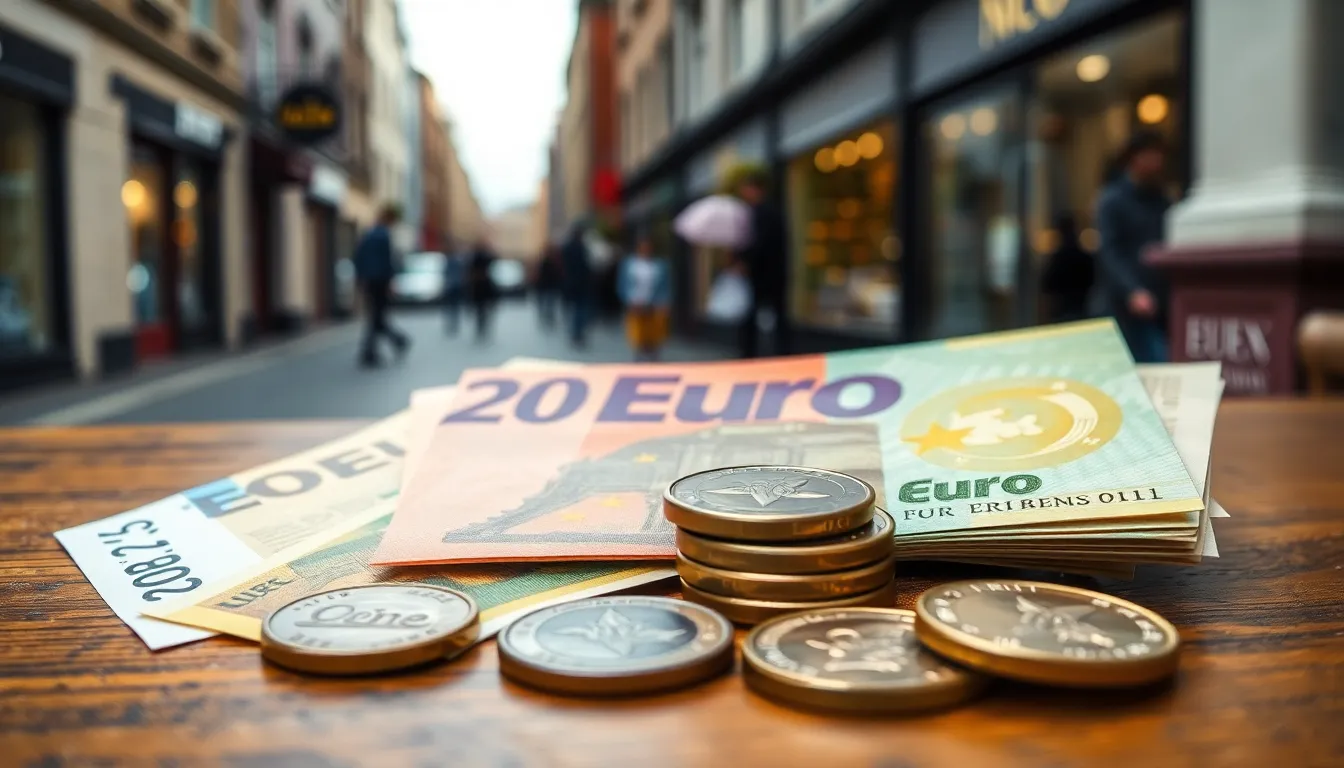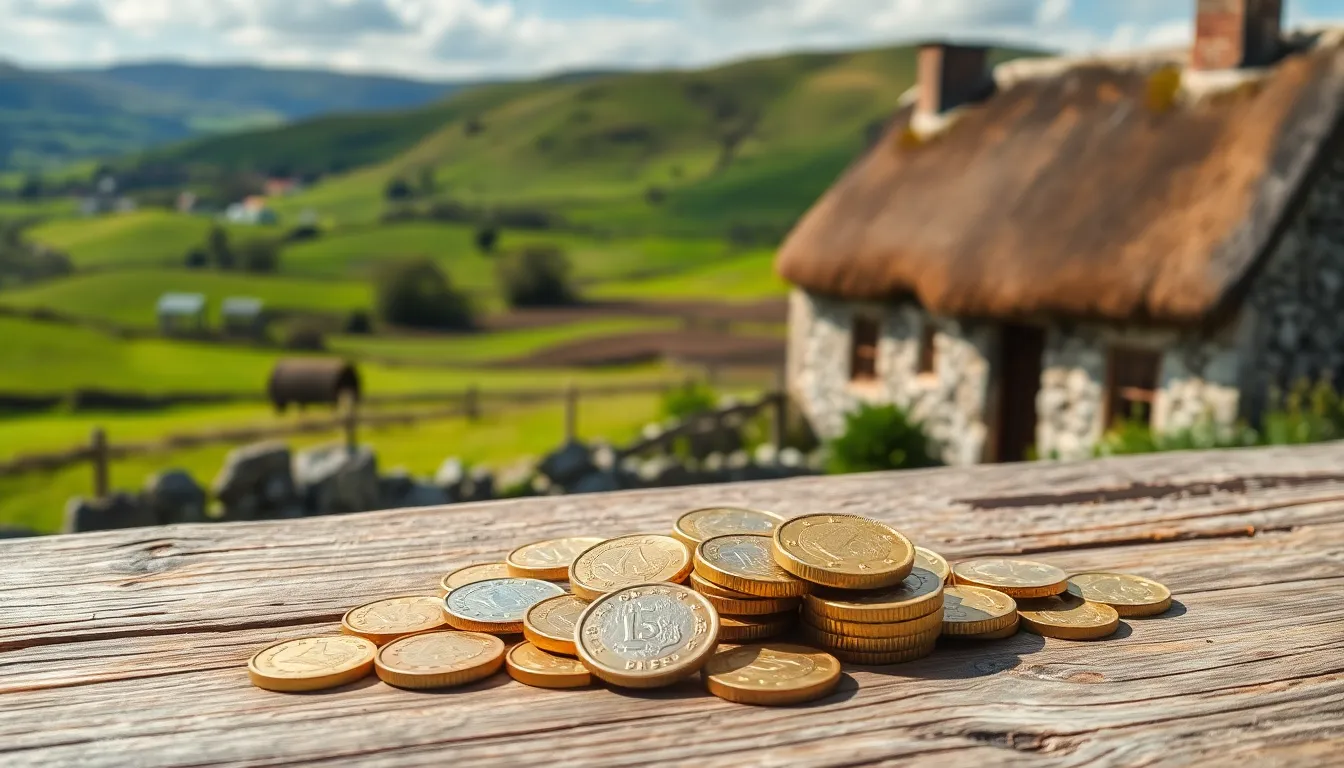When it comes to Ireland, most people think of lush landscapes, friendly locals, and maybe a pint of Guinness. But what about its currency? If you’re planning a trip or just curious about the Emerald Isle, knowing what money Ireland uses is essential. Spoiler alert: it’s not leprechaun gold, though that would be quite convenient!
Table of Contents
ToggleOverview of Ireland’s Currency
Ireland primarily uses the euro as its official currency. The euro symbol, €, represents various denominations in coins and banknotes. Coins come in 1 cent, 2 cent, 5 cent, 10 cent, 20 cent, and 50 cent values, along with 1 euro and 2 euro coins. Banknotes exist in €5, €10, €20, €50, and €100 amounts.
The transition to the euro began in 2002, replacing the Irish pound. This move aimed to increase economic stability and integration within the European Union. Many travelers prefer the euro for convenience, allowing seamless transactions across eurozone countries.
Understanding exchange rates is crucial when converting foreign currencies to euros. Rates fluctuate based on market conditions, so checking them before traveling ensures better budget management. Numerous banks and currency exchange services provide currency conversion, often charging a fee.
Credit and debit cards are widely accepted throughout Ireland, with Visa and Mastercard being the most common. Contactless payment options also facilitate quick transactions, enhancing the experience for tourists. Travelers should inform their banks of their travel plans to avoid issues with card usage abroad.
In Ireland, cash is still used, particularly in rural areas or small businesses. Many small vendors prefer cash payments for lower transaction fees. Carrying a small amount of euros is advisable for instances where cards might not be accepted.
Overall, familiarity with the euro and varying payment methods enhances visitors’ experiences in Ireland.
The Euro: Ireland’s Current Currency

Ireland uses the euro (€) as its official currency. Transitioning to the euro in 2002 marked a significant step in the nation’s economic integration within the European Union.
History of the Euro in Ireland
Ireland adopted the euro on January 1, 1999, participating in a larger initiative to create a unified currency for Eurozone countries. By 2002, euro banknotes and coins replaced the Irish pound, facilitating easier trade and travel. The euro strengthened Ireland’s economy by promoting stability and opening up opportunities for investment. Since its introduction, the euro has played a vital role in shaping Ireland’s financial landscape.
Value and Exchange Rates
Exchange rates for the euro fluctuate based on market conditions, impacting travelers converting foreign currencies. Regularly checking current rates helps individuals plan their budgets effectively. Banks and currency exchange services provide varied rates, so comparing options is crucial. Major credit cards are widely accepted, which reduces the need for extensive cash. Visitors often benefit from using euros to avoid additional conversion fees and ensure smoother transactions.
The Transition from the Irish Pound
The transition from the Irish pound marked a significant change in Ireland’s monetary landscape.
Historical Significance of the Irish Pound
The Irish pound served as Ireland’s currency from 1928 until its replacement by the euro in 2002. It symbolized the nation’s economic independence following its establishment as a republic. The pound underwent several changes in its design and issuance over the years, reflecting the evolving national identity. Importantly, coins depicted historical figures and elements of Irish culture, enhancing the sense of national pride. Collectively, this currency represented not just economic activity but also a crucial part of Ireland’s historical narrative as it navigated global financial landscapes.
Factors Leading to the Transition
Several factors led to the transition from the Irish pound to the euro. Economic integration within the European Union promoted the adoption of a unified currency. Ireland’s membership in the EU encouraged stability and growth, facilitating trade and investment. The benefits of a single currency became evident as cross-border transactions improved. Additionally, fluctuations in the pound posed challenges for businesses and consumers alike. Ultimately, the euro provided a solution, enhancing convenience and reducing currency risk for those traveling and trading internationally.
Currency Symbols and Coins in Ireland
Ireland uses the euro (€) as its official currency. This currency has both banknotes and coins that travelers encounter.
Euro Banknotes
Euro banknotes come in seven denominations. These include €5, €10, €20, €50, €100, €200, and €500. Each banknote features unique designs that symbolize European unity and culture. Security features include watermarks, holograms, and color-shifting ink to prevent counterfeiting. Many businesses and establishments readily accept the various banknotes, making transactions straightforward for visitors.
Euro Coins
Euro coins are available in eight denominations. These consist of 1 cent, 2 cents, 5 cents, 10 cents, 20 cents, 50 cents, €1, and €2. Each coin exhibits a common European side and a national side unique to Ireland. The national side often showcases iconic symbols, like the harp or girl in a gown. These coins are essential for small purchases, especially in local markets and rural areas where cash may be preferred. Coins facilitate quick transactions, enhancing the overall experience for people exploring Ireland.
Impact of Currency on Tourism
The euro (€) significantly affects tourism in Ireland. Travelers from eurozone countries experience seamless transactions, while visitors from outside the eurozone face currency exchange considerations.
Currency Exchange for Tourists
Currency exchange centers thrive in major cities and tourist hotspots. Travelers can exchange their cash at airports, banks, and dedicated exchange services. Rates fluctuate daily, so checking several options ensures better deals. Many visitors compare conversion rates, which helps them avoid excessive fees. ATMs provide convenient access to euros with international cards. Some banks impose withdrawal limits, so planning ahead prevents inconvenience. Always consider using a mix of cash and cards for flexibility during trips.
Tips for Travelers
Travelers should carry a small amount of euros for tips and small purchases. Using credit or debit cards remains popular for larger transactions. Planning purchases with local currency preserves budget control. It’s wise to inform banks of travel plans to avoid card service disruptions. Familiarity with local payment methods improves the shopping experience. While most urban establishments accept cards, traditional markets and rural shops often prefer cash. Overall, understanding these tips enhances the travel experience in Ireland.
Understanding the euro is essential for anyone visiting Ireland. It simplifies transactions and enhances the overall travel experience. With its various denominations and wide acceptance, the euro serves as a reliable currency for both locals and tourists.
Travelers should remember to carry some cash for small purchases while also taking advantage of card payments for larger expenses. Keeping an eye on exchange rates can help manage budgets effectively and avoid unnecessary fees. By familiarizing themselves with Ireland’s currency, visitors can navigate the country with ease and enjoy all it has to offer.



